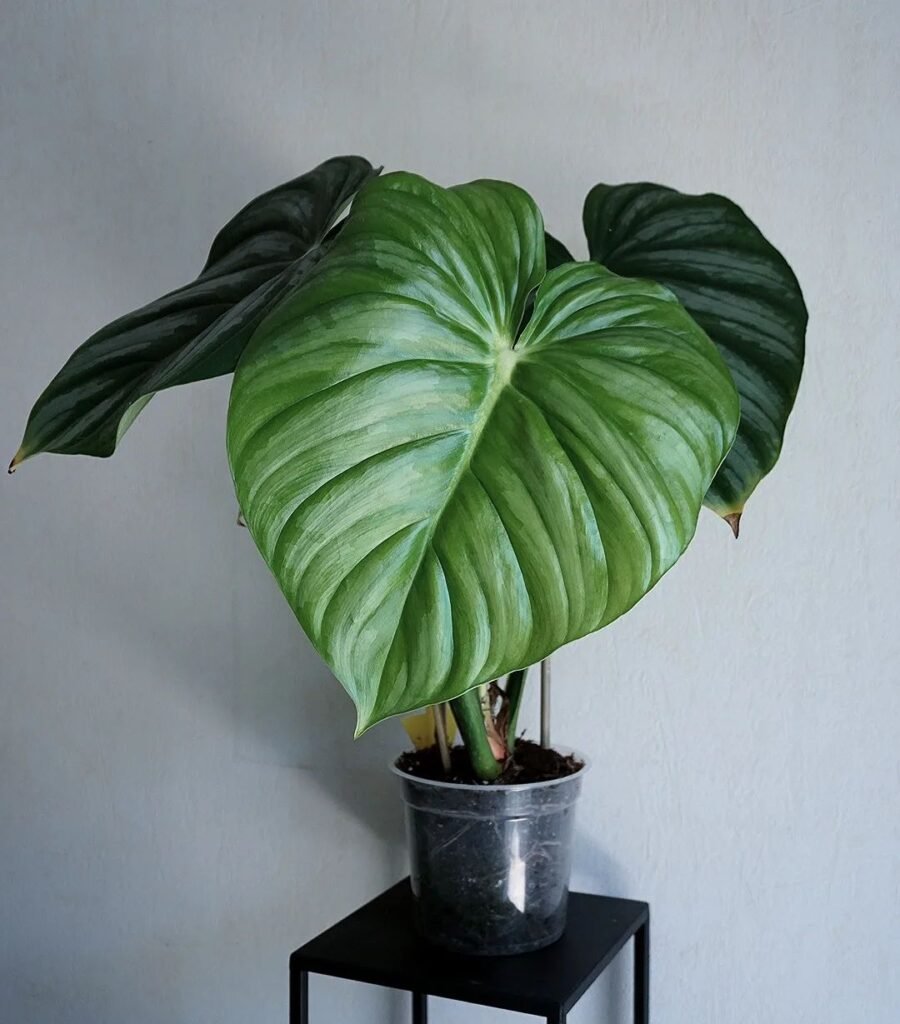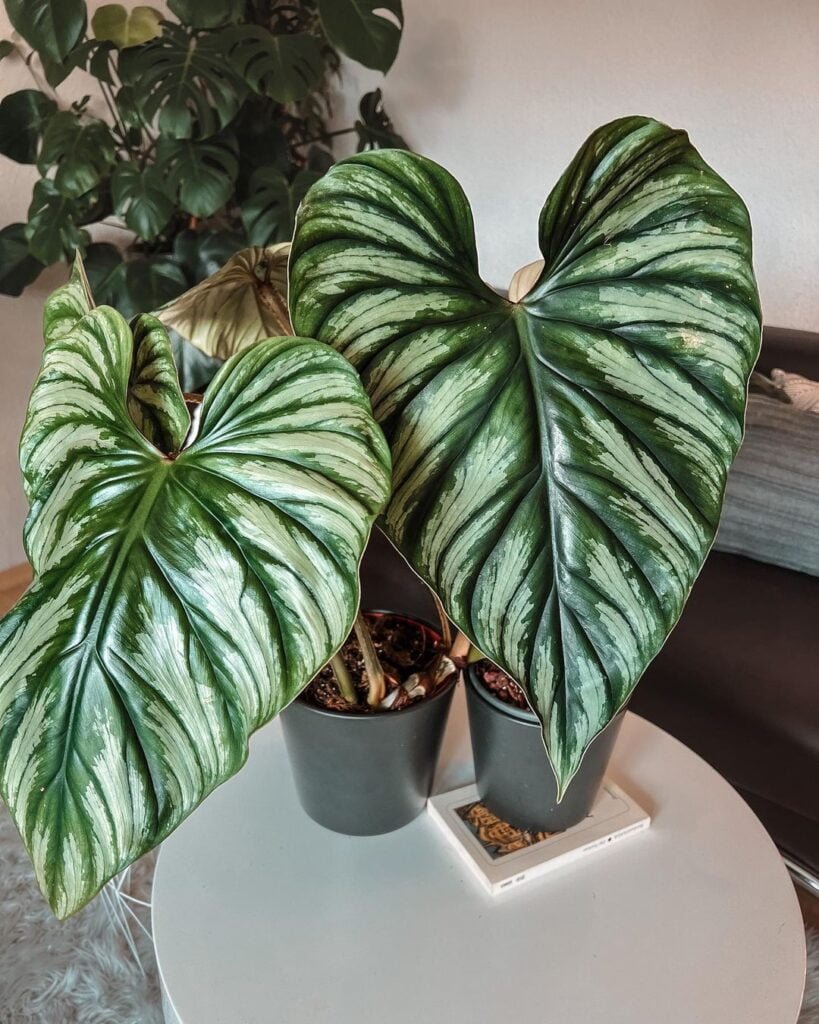Every plant enthusiast understands the thrill that comes with growing rare, eye-catching indoor plants. The Philodendron Plowmanii is one such specimen, revered for its impressive size and exquisite beauty. Yet, despite its regal appearance, this houseplant is relatively low-maintenance and can be successfully grown indoors with some care and knowledge.
Understanding The Rare Philodendron Plowmanii
Step into the lush rainforests of Peru, where the distinguished Philodendron Plowmanii finds its roots. Part of the extensive Araceae family, this rare gem is a standout with its grand, luxurious leaves. Enchanting silver and green hues dance across each leaf’s surface, echoing the plant’s exotic origins and transforming your living space into a tropical haven.
Unlike the typical upright growth of many houseplants, the Philodendron Plowmanii prefers a different approach. It grows in a stunning rosette form, unfurling its large leaves around a central point, creating an awe-inspiring display that never fails to captivate. The Philodendron Plowmanii doesn’t just occupy space in your home, it commands it, drawing attention from all who pass by. The mere sight of this extraordinary plant is a daily reminder of the unique, compelling world of botany that extends far beyond our everyday experiences.
Yet, for all its exotic appeal, the Philodendron Plowmanii is unpretentious and adaptable, comfortably settling into indoor conditions. But understanding its native environment and growth habits can provide valuable insights into providing the best possible care, ensuring that this majestic plant not only survives but thrives in your indoor jungle. It’s commanding presence and elegant form add a touch of the extraordinary to the everyday, making the Philodendron Plowmanii an indispensable member of your plant family.
Philodendron Squamicaule Care Guide
The Ideal Environment for Growing Philodendron Plowmanii
Creating the perfect environment for your Philodendron Plowmanii to flourish begins with understanding its tropical roots. Imagine the lush Peruvian rainforest, home to this rare beauty, and try to mirror the conditions in your living space. First off, temperature. The Philodendron Plowmanii is a fan of the warmth, finding comfort in temperatures that span from 65 to 80 degrees Fahrenheit.
Another crucial factor is humidity. Mimicking the moist, dew-laden air of the rainforest will make your Philodendron Plowmanii feel right at home. Consider placing it in a bathroom, where steam from hot showers can create a pseudo-tropical environment. Alternatively, you could invest in a humidity tray or humidifier to keep your plant content.
Lighting is also key to helping this plant thrive. Although the Philodendron Plowmanii can tolerate lower light conditions, it has a particular affinity for bright, indirect sunlight. Consider placing it near a north or east-facing window to provide it with the perfect lighting. However, avoid subjecting it to harsh, direct sunlight, as this can cause unsightly burns on its stunning leaves.
It’s all about recreating the conditions of its natural habitat as closely as possible. With the right environment, your Philodendron Plowmanii will not just grow, but truly flourish, showcasing its full, majestic beauty to anyone lucky enough to witness it.
10 Philodendron Varieties: A Comprehensive Guide
Watering and Feeding: Essential Needs for Philodendron Plowmanii

Just as the Philodendron Plowmanii charms us with its elegant form and grandeur, it too, has needs. Two of the most significant ones are watering and feeding.
When it comes to watering, the Philodendron Plowmanii has a strong preference for consistency. Envision the regular rainfall in its native Peruvian rainforest home. The goal is to keep its environment somewhat moist, but not soaked. A smart way to gauge this is by examining the top inch of the soil. If it’s dry, that’s your cue to water the plant. However, caution is required to avoid overwatering, which could lead to waterlogged soil and root rot. Maintaining a healthy balance is key.
Just as you need a balanced diet to flourish, so does your Philodendron Plowmanii. Feeding your plant adequately is just as vital as proper watering. During its active growing season, your Philodendron Plowmanii will appreciate a water-soluble fertilizer every couple of weeks. This regular feeding schedule aids in supporting the plant’s vigorous growth and ensuring the perpetuation of its captivating beauty.
Remember, when you meet your Philodendron Plowmanii’s watering and feeding needs, you’re not just helping it survive. You’re empowering it to thrive, allowing it to fully express its majestic form, and continue to grace your living space with its commanding presence. Just like us, every plant has a language. Listen to your Philodendron Plowmanii’s needs, respond accordingly, and watch in awe as it flourishes in return.
Philodendron Gloriosum: Easy Care For Healthy Plant
The Importance of Proper Soil and Drainage
Creating an optimal growth environment for your Philodendron Plowmanii doesn’t end with temperature, light, and humidity. Another vital consideration is the type of soil in which you plant this exotic gem. The right soil mix does not merely serve as an anchor for the roots but also plays a vital role in providing the essential nutrients the plant needs to thrive. And that’s not all! It’s your soil’s job to distribute water evenly, ensuring that every root gets a good drink, while also making sure they don’t drown in the process.
Let’s delve into what this means for your Philodendron Plowmanii. Picture a balance scale; on one side, there’s moisture retention for the thirsty roots, and on the other side, there’s drainage to prevent waterlogging. Your goal is to create an ideal soil blend that maintains this equilibrium. A combination of peat, perlite, and orchid bark has proven to be a reliable mix for the Philodendron Plowmanii.
Peat retains moisture without becoming waterlogged, keeping the roots hydrated but not soggy. Perlite and orchid bark, on the other hand, offer excellent drainage, ensuring excess water doesn’t sit idle, potentially causing root rot.
There’s more! Remember the pot you choose for your Philodendron Plowmanii is equally crucial. Yes, it’s essential for aesthetic reasons. However, more importantly, it’s fundamental for proper drainage. Your chosen pot should come equipped with ample drainage holes, allowing excess water an easy escape route.
You see, the right soil and a suitable pot together make a formidable team. They protect your Philodendron Plowmanii’s roots from an aquatic onslaught and promote healthy, vibrant growth. Let’s not forget that plants, like people, need a good home base to thrive. By providing the right soil and drainage, you’re setting up your Philodendron Plowmanii for the long, healthy life it deserves.
Split Leaf Philodendron: Care, Types, And Growing Tips
Repotting Your Philodendron Plowmanii
Transplanting your Philodendron Plowmanii into a fresh pot is a relatively straightforward task that doesn’t need to happen often. Think of it like giving your plant a roomier home when it’s outgrown its current space. This usually happens every 2-3 years or when you see that its roots are filling up the entire pot, giving it a pot-bound appearance.
As you go about repotting, be sure to do so with a soft touch. This plant’s roots are delicate and can be easily damaged. Approach the task with care, ensuring you don’t jostle or harm the root system. Remember, these roots are the lifeline of your Philodendron Plowmanii. They draw up the essential water and nutrients it needs to flourish. Any damage can significantly affect the plant’s health and vitality.
When you’ve carefully extracted your plant from its current pot, it’s time to introduce it to its new abode. As we mentioned before, the right kind of soil is crucial for the wellbeing of your Philodendron Plowmanii. A fresh mix of well-draining soil can reinvigorate your plant, encouraging stronger and healthier growth.
Repotting is like giving your Philodendron Plowmanii a mini makeover, a refreshing new start. And like any good makeover, it should be done delicately, with plenty of care and attention to detail.
Philodendron Prince Of Orange Care & Growing Guide
Tips for Propagating Philodendron Plowmanii
Looking to grow your plant family and share the beauty of your Philodendron Plowmanii? Propagation, or producing new plants from existing ones, is an exciting process that lets you do just that. Thankfully, propagating this captivating plant is quite straightforward, even for beginners.
Start by selecting a healthy stem from your plant. This should be a mature stem with at least two nodes (the bumps on the stem where new growth sprouts). These nodes are crucial as they’re where the roots will develop.
Once you’ve taken your cutting, you have two primary options for propagation: water or soil. If you opt for water propagation, submerge the cut end of the stem in a container of clean water. Make sure to refresh the water every few days to prevent bacteria from hindering root development.
Alternatively, you could plant the cutting directly into moist soil. This method mimics the natural process more closely and can often result in stronger plants. Regardless of the method you choose, make sure the nodes are in contact with the water or soil.
And then comes the exciting part – watching and waiting! Within a few weeks, you should start to see tiny roots appearing. It’s a magical moment that’s sure to bring a smile to any plant lover’s face.
Once a healthy root system has developed, you can transition your new Philodendron Plowmanii plant to a pot, using the same soil blend and potting advice as detailed earlier in this guide.
Remember, propagation isn’t an exact science and each plant is unique. Don’t be discouraged if your first attempt doesn’t go as planned. Patience and persistence are key. After all, nurturing new life is always an adventure and one of the most rewarding aspects of being a plant parent. So, why not give it a try and multiply the splendor of Philodendron Plowmanii in your home?
10 Plants With Heart-Shaped Leaves Add Love To Your Home
Troubleshooting Common Philodendron Plowmanii Problems
Just like humans, plants can also experience health problems. When it comes to the Philodendron Plowmanii, there are several common issues that may arise, each one telling a different story about what your plant might need. Fear not, though. With a keen eye and a bit of knowledge, you’ll be able to decipher these clues and nurse your Philodendron Plowmanii back to health.
One telltale sign of trouble is yellowing leaves. If you find your plant’s lush green hues replaced with a sad yellow, your plant may be getting too much water. Before you reach for the watering can next time, remember to check the top inch of soil for dryness.
Conversely, browning leaves could be a cry for more humidity. If you’ve been slacking off on misting your plant or keeping it in a humid environment, it’s time to up your game. Consider moving your Philodendron Plowmanii to a steamier location or investing in a humidifier.
But what if your plant seems to be stuck in time, not showing any new growth? It could be a sign that your plant isn’t getting enough light or nutrients. Re-evaluate your plant’s location, ensuring it’s receiving bright, indirect sunlight. Also, make sure you’re feeding it a well-balanced diet of water-soluble fertilizer during its growing season.
Troubleshooting plant problems is a bit like being a detective. You need to look for clues, interpret them, and respond appropriately. It’s a journey of learning and growing alongside your plant. But remember, it’s worth every moment when you see your Philodendron Plowmanii regain its majestic beauty and continue to thrive.


Pingback: 10 Plants Perfect for Hardwood Cuttings & How to Propagate
Pingback: Philodendron Giganteum Care Guide -
Pingback: The Unique African Milk Tree: An Easy-Care Succulent - Gardener's School